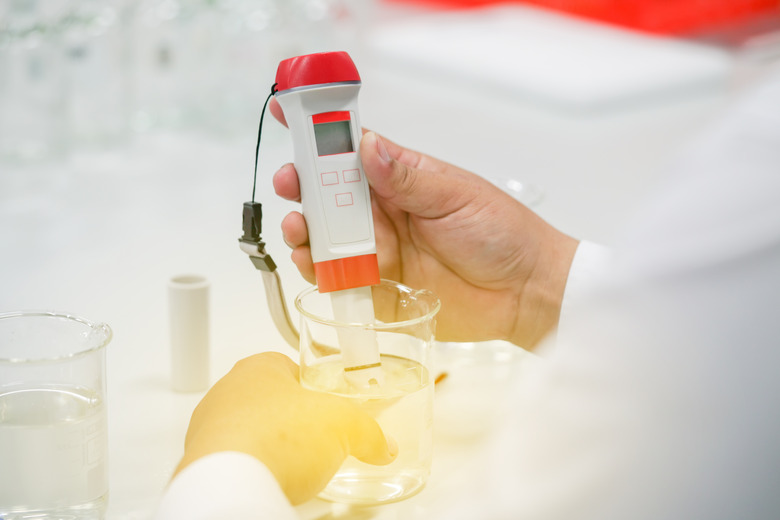What Is Buffer Solution?
There are a number of applications in chemistry and biology where changes in pH can have a major negative effect. One example of this exists in the human body; changes to blood pH could have a devastating effect, so a mechanism within the body known as the bicarbonate buffering system keeps your blood's pH in check. In laboratory settings, buffer solution is used to achieve similar results. The buffer solution maintains a balance in the pH of whatever is being worked with, preventing outside influences from shifting the pH and potentially ruining everything.
TL;DR (Too Long; Didn't Read)
A buffer solution is made up of a weak acid and its conjugate base or a weak base and its conjugate acid. The two components maintain a pH balance that resists change when strong acids or bases are added to it.
Buffer Solutions
Buffer Solutions
A buffer solution is a solution containing both an acid and a base. The solution is made by taking a weak acid and adding its conjugate base (which is formed by removing a proton from the same type of acid) or by combining a weak base with its conjugate acid. The use of conjugates is what gives a buffer solution its resistance to pH changes; it creates an equilibrium between the acid and the base which is difficult for other acids or bases to overcome. Even when strong acids or bases are added, the equilibrium between the weak acid/base and its conjugate reduce the impact of the addition on overall solution pH.
Buffering pH
Buffering pH
Buffer solutions have a wide range of applications, both in the real world and in the lab. A buffered pH is required for most enzymes to function correctly, and buffering is used to ensure proper color concentration when using dyes. Buffer solutions are also used to calibrate equipment, especially pH meters that might be miscalibrated if a buffer is not present. It's worth noting that buffer solutions do not necessarily have a neutral pH, just a balanced one; buffer solutions made from citric acid, ammonia, acetic acid (which is found in vinegar in low concentrations) and other compounds can have pH values as low as 2 or higher than 10. This allows the use of buffer solutions in work with very strong acids or bases.
Buffer Capacity
Buffer Capacity
While buffer solutions are resistant to changes in pH, this doesn't mean that the pH of a buffer solution can't change if enough strong acid or strong base is added. The amount of a strong acid or base that a buffer solution can take before significant pH changes occur is known as the buffer capacity. The capacity differs depending on the core components of the buffer solution and how much of the strong acid or base is added to the solution. If adding a strong acid to the buffer solution, the capacity is equal to the amount of the base in the solution. If adding a strong base, the capacity is equal to the amount of the acid in the solution.
Cite This Article
MLA
Gerard, Jack. "What Is Buffer Solution?" sciencing.com, https://www.sciencing.com/what-is-buffer-solution-13712160/. 18 May 2018.
APA
Gerard, Jack. (2018, May 18). What Is Buffer Solution?. sciencing.com. Retrieved from https://www.sciencing.com/what-is-buffer-solution-13712160/
Chicago
Gerard, Jack. What Is Buffer Solution? last modified March 24, 2022. https://www.sciencing.com/what-is-buffer-solution-13712160/
